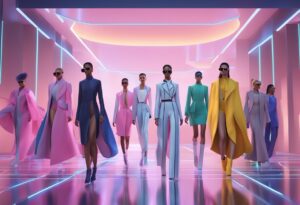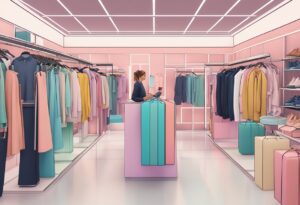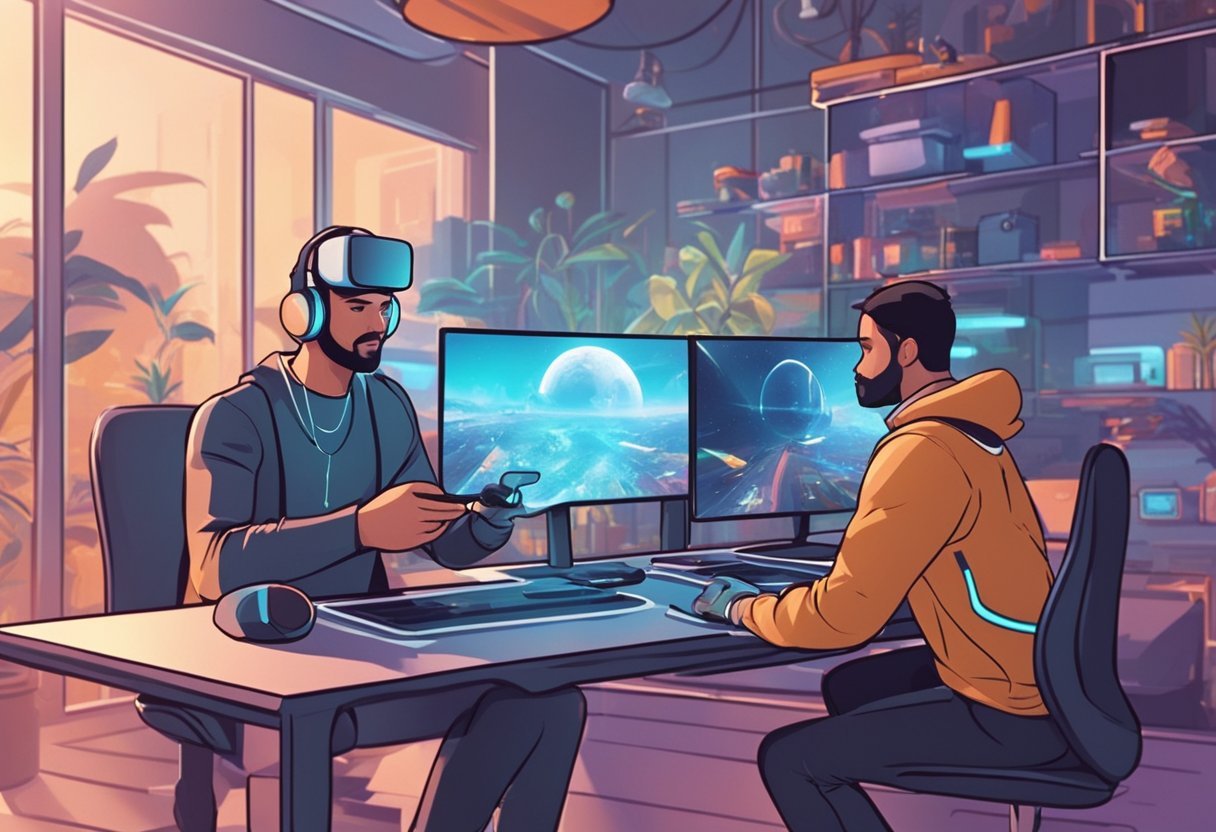Fashion in the metaverse is an emerging trend that is gaining popularity among tech-savvy consumers. The metaverse is a virtual reality that integrates both digital and physical worlds, and fashion brands are investing in it to engage with their customers. The metaverse offers a hyper-interactive, creative digital environment where people can shop, socialize, and play.
Digital fashion is an essential aspect of the metaverse, where people can dress up their avatars in a variety of ways. The fashion industry is capitalizing on this trend by creating virtual clothing, which can be bought and worn in the metaverse. Brands are using NFTs, gaming, and virtual fashion to enhance their creativity, community, and commerce.
The metaverse is an opportunity for fashion brands to experiment with new designs and create unique experiences for their customers. As technology continues to evolve, the metaverse is likely to become an integral part of the fashion industry. Fashion in the metaverse offers opportunities for sustainability, creativ
Evolution of Fashion in the Metaverse
The concept of virtual fashion has been around for years, but it was not until the pandemic that it gained mainstream attention.
With people stuck at home, digital fashion became a way for individuals to express themselves and try new styles without leaving their homes. This led to an increase in demand for digital collections, which allowed fashion houses to showcase their designs in a virtual space.
Impact of the Pandemic
The pandemic has had a significant impact on the fashion industry, with physical fashion shows and events being canceled or postponed.
This led to the rise of Metaverse Fashion Week, where designers could showcase their collections in a virtual space. This allowed for a wider audience to view the collections and provided a unique and innovative way for designers to showcase their work.
Metaverse Fashion Week
Metaverse Fashion Week has quickly become a platform for designers to showcase their digital collections. The event brings together designers, artists, and creators to showcase their work in a virtual space. It has also provided an opportunity for emerging designers to showcase their work and gain exposure.
Metaverse Fashion Week has become a significant event in the fashion industry and is expected to continue to grow in the future.
The pandemic has accelerated the growth of virtual fashion, and Metaverse Fashion Week has become a significant event in the fashion industry. The rise of digital collections and virtual fashion shows has provided a unique and innovative way for designers to showcase their work.
As technology continues to advance, it is expected that virtual fashion will continue to grow and become an integral part of the fashion industry.
How to start business fashion work in the metaverse
Starting a fashion business in the metaverse involves understanding both the fashion industry and the digital landscape of virtual worlds. Here’s a step-by-step guide to help you navigate this process:
Step 1: Research and Conceptualize
Begin by researching the metaverse and its current platforms. Understand where fashion fits into these digital spaces and conceptualize your fashion business idea. Consider what kind of fashion you want to create, whether it’s high-end, streetwear, or something entirely new that leverages the unique possibilities of the metaverse.
Step 2: Identify Your Target Audience
Define who your target customers are. In the metaverse, this could include gamers, virtual world inhabitants, digital collectors, and fashion enthusiasts. Knowing your audience will guide your designs, platform choices, and marketing strategies.
Step 3: Learn About NFTs and Blockchain
Familiarize yourself with NFTs and blockchain technology, as they are integral to verifying ownership and authenticity of digital assets in the metaverse. Understanding these technologies will help you manage digital inventory and sales.
Step 4: Choose the Right Platform
Select a metaverse platform that aligns with your brand identity and target audience. Popular choices include Decentraland, The Sandbox, Roblox, and VRChat. Each platform has its own tools and audience, which will affect how you present and sell your fashion items.
Step 5: Create Your Digital Fashion Items
Design your digital fashion collection. You may need to hire 3D designers or learn 3D modeling software to create your items. Ensure that your designs are compatible with the chosen metaverse platform’s specifications.
Step 6: Develop a Virtual Storefront
Create a virtual space where customers can view and purchase your fashion items. This could be a standalone store in a virtual world, a booth in a digital marketplace, or a partnership with an existing virtual retailer.
Step 7: Market Your Brand
Develop a marketing strategy that includes social media, collaborations with influencers, and participation in virtual events. Engaging with the community is crucial, as word-of-mouth can be a powerful tool in the metaverse.
Step 8: Launch and Sell
Open your virtual store and start selling your digital fashion items. Monitor sales and customer feedback to understand what works and what doesn’t, allowing you to adapt and refine your offerings.
Step 9: Provide Customer Support
Offer customer support to handle any issues with purchases, product information, or technical problems. Good customer service will help build your reputation in the metaverse.
Step 10: Expand and Innovate
As your business grows, look for opportunities to expand. This could involve branching out to other virtual platforms, collaborating with other brands, or exploring new forms of digital fashion and experiences.
Technological Foundations
Blockchain technology and non-fungible tokens (NFTs) are essential components of the metaverse fashion industry. NFTs allow creators to authenticate and sell unique digital assets, such as virtual clothing and accessories, in a secure and transparent manner. The blockchain technology behind NFTs ensures that each item is unique and cannot be replicated, making it a valuable asset in the digital world.
Virtual and Augmented Reality
Virtual and augmented reality technologies are transforming the way people interact with fashion in the metaverse. These technologies allow users to create and try on virtual clothing, experiment with different styles and colors, and even attend virtual fashion shows.
Virtual and augmented reality technologies also provide a more immersive and personalized experience for consumers, allowing them to engage with fashion in a whole new way.
AI and Digital Design
Artificial intelligence (AI) and digital design tools are also playing a crucial role in the metaverse fashion industry. AI-powered algorithms can analyze consumer data to predict fashion trends and create personalized recommendations for users.
Digital design tools allow designers to create and manipulate virtual clothing and accessories, enabling them to experiment with new styles and designs in a more efficient and cost-effective way.
The technological foundations of the metaverse fashion industry are built on blockchain and NFTs, virtual and augmented reality, and AI and digital design tools. These technologies are transforming the way people interact with fashion, creating new opportunities for engagement and personalization.
Fashion Industry Meets Metaverse

The fashion industry has been quick to recognize the potential of the metaverse, a rapidly growing digital universe that is transforming the way consumers interact with brands. As the convergence of the physical and digital worlds continues, the metaverse presents exciting opportunities for luxury brands, retailers, and consumers themselves.
In this section, we explore how the fashion industry is embracing the metaverse, with a particular focus on brand collaborations, digital fashion houses, and metaverse-native brands.
Brand Collaborations
One of the ways in which the fashion industry is entering the metaverse is through collaborations with other brands. By partnering with metaverse platforms and other companies, fashion brands can extend their reach and engage with new audiences.
For example, luxury fashion house Balenciaga partnered with the online gaming platform Fortnite to launch a virtual fashion show in the metaverse. The show attracted millions of viewers and showcased the potential of the metaverse as a platform for immersive brand experiences.
Digital Fashion Houses
Another way in which the fashion industry is embracing the metaverse is through the creation of digital fashion houses. These companies specialize in creating virtual clothing and accessories that can be worn in the metaverse.
By focusing on the digital realm, these companies are able to experiment with new designs and materials that would be impossible in the physical world. Digital fashion houses also offer a more sustainable alternative to traditional fashion, as there is no need for physical production or shipping.
Metaverse-Native Brands
Finally, we have metaverse-native brands, which are companies that have been created specifically for the metaverse. These brands are often run by gamers or other metaverse enthusiasts, and they specialize in creating virtual clothing, accessories, and other digital products.
Metaverse-native brands offer a unique perspective on fashion, as they are not bound by the constraints of the physical world. They are also able to experiment with new business models and revenue streams, such as selling virtual goods or offering virtual experiences.
The fashion industry is rapidly embracing the metaverse, with brand collaborations, digital fashion houses, and metaverse-native brands leading the way. As the metaverse continues to grow and evolve, we can expect to see even more innovative approaches to fashion and brand experiences in this exciting new digital realm.
Consumer Interaction and Commerce in the Metaverse
The metaverse has opened up a new world of opportunities for the fashion industry to engage with consumers and drive commerce. Here are some key ways in which consumers are interacting with fashion in the metaverse.
Virtual Showrooms and Stores
Virtual showrooms and stores are becoming increasingly popular in the metaverse. These digital spaces allow consumers to browse and purchase virtual outfits, which can be worn by their avatars in the virtual world. Luxury brands and retailers are leveraging this trend to create immersive brand experiences and reach a wider audience. Virtual showrooms and stores also offer the advantage of being accessible 24/7, which is not possible with physical stores.
Digital Ownership and Resale
Digital ownership and resale of virtual fashion items is another emerging trend in the metaverse. Consumers can purchase NFT garments, which are unique and can be owned and traded like physical assets. This creates a new market for fashion items that are not bound by physical limitations. Furthermore, digital ownership and resale can also help reduce waste and promote sustainability in the fashion industry.
The Role of Avatars
Avatars play a crucial role in the metaverse, especially when it comes to fashion. Consumers can customize their avatars to reflect their personal style and preferences. Avatars also serve as a way for consumers to try on virtual outfits before purchasing them. This feature helps consumers make more informed decisions about their purchases and reduces the likelihood of returns.
The metaverse is transforming the way consumers interact with fashion and driving new opportunities for commerce. Virtual showrooms and stores, digital ownership and resale, and the role of avatars are just some of the ways in which fashion is evolving in the metaverse.

How fashion work in the metaverse
Fashion in the metaverse operates on a different paradigm compared to the physical world. It’s a digital space where creativity and expression are not limited by physical constraints, allowing for innovative and immersive experiences. Here’s how fashion functions in the metaverse:
Virtual Clothing and Accessories
Brands create digital garments and accessories that users can purchase for their avatars. These items often mimic real-world designs but can also include fantastical elements that would be impossible or impractical to produce physically.
NFTs and Ownership
Fashion items in the metaverse can be bought and sold as NFTs (Non-Fungible Tokens), providing proof of ownership and authenticity. This blockchain technology ensures that digital fashion pieces are unique and can be collected or traded like physical fashion items.
Digital Fashion Shows
Designers can showcase their collections through virtual fashion shows. These events can take place in various virtual worlds or platforms, allowing global audiences to attend without geographical limitations, often providing a more interactive and engaging experience than traditional shows.
Brand Experiences and Engagement
Fashion brands create immersive experiences within the metaverse to engage with consumers. This could include virtual stores, interactive campaigns, or collaborative events within gaming platforms or other virtual spaces.
Customization and Personalization
Users can often customize their digital fashion items, allowing for a high degree of personalization. This could mean adjusting colors, patterns, or even the shape and form of the items to fit their avatar’s aesthetic.
Cross-Platform Utility
Some digital fashion items can be used across different platforms and games, providing users with a consistent identity and style as they navigate through various virtual spaces.
Sustainable and Ethical Considerations
Digital fashion offers a sustainable alternative to fast fashion, as it requires no physical materials to produce and has no environmental impact. It also circumvents ethical concerns associated with manufacturing.
Economic Opportunities
The metaverse opens up new revenue streams for fashion brands and designers. It allows them to sell digital fashion items directly to consumers within these virtual worlds, often leading to new business models and marketplaces.
Community and Culture
Fashion in the metaverse contributes to the culture and community of virtual worlds. Just like in real life, what one’s avatar wears can signify their identity, status, and belonging to a particular community or fandom within the metaverse.
The metaverse fashion industry is still in its infancy, but it’s rapidly evolving. Brands are exploring this new frontier, recognizing its potential to transform how we think about fashion, self-expression, and social interaction in digital spaces.
Sustainability and Ethical Considerations
Environmental Impact
As the fashion industry continues to explore the metaverse, sustainability and its impact on the environment must be taken into account. The use of virtual clothing and accessories can potentially reduce the carbon footprint associated with traditional fashion production. However, the energy consumption required to power the metaverse must also be considered.
One potential solution is the use of renewable energy sources to power the metaverse. The use of sustainable materials, such as those made from algae extract or silk cocoon protein, can be explored in the production of virtual clothing.
Counterfeiting and Authenticity
With the rise of metaverse fashion, the issue of counterfeiting and authenticity must also be addressed. The ease of replicating virtual clothing and accessories can make it difficult to distinguish between authentic and counterfeit items.
One potential solution is the use of blockchain technology to track the ownership and authenticity of virtual items. Educating consumers on the importance of purchasing authentic virtual items can help to combat the issue of counterfeiting.
Inclusivity in the Digital Space
The metaverse has the potential to create a more inclusive and diverse fashion industry. Virtual clothing and accessories can be designed to fit a wider range of body types and sizes, allowing for greater representation in fashion.
However, it is important to ensure that virtual clothing and accessories are not designed to perpetuate harmful stereotypes or discriminatory practices. The fashion industry must continue to prioritize inclusivity and diversity in the metaverse.
Sustainability and ethical considerations are crucial in the development of metaverse fashion. The fashion industry must prioritize the use of sustainable materials and renewable energy sources, combat counterfeiting and promote authenticity, and prioritize inclusivity and diversity in the digital space.
Frequently Asked Questions
What are the leading fashion brands currently active in the metaverse?
A growing number of fashion brands are entering the metaverse to explore new opportunities for creativity, community building, and commerce. Some of the leading fashion brands currently active in the metaverse include Balenciaga, Louis Vuitton, Gucci, and Burberry.
How can users experience Fashion Week within the metaverse?
Fashion Week is one of the most anticipated events in the fashion industry, and the metaverse has opened up new ways for users to experience it. Users can attend virtual fashion shows, interact with digital avatars, and purchase virtual fashion items. Some popular metaverse platforms for experiencing Fashion Week include Decentraland, CryptoVoxels, and Somnium Space.
Which notable fashion designers have established a presence in the metaverse?
Several notable fashion designers have established a presence in the metaverse to showcase their collections and engage with their fans. Some of these designers include Marc Jacobs, Tommy Hilfiger, and Donatella Versace. They have created virtual stores, avatars, and fashion shows to showcase their designs to a global audience.
What are some prominent fashion-focused projects emerging in the metaverse?
The metaverse is a hub of creativity, and several fashion-focused projects are emerging in this space. Some prominent fashion-focused projects include virtual fashion shows, digital clothing collections, and NFT-based fashion items. These projects are pushing the boundaries of what is possible in the fashion industry and creating new opportunities for designers and consumers alike.
How has digital fashion evolved with the advent of the metaverse?
Digital fashion has evolved significantly with the advent of the metaverse. Designers are now creating virtual garments that can be worn by digital avatars, and users can purchase these items using cryptocurrencies. The metaverse has also enabled designers to showcase their collections to a global audience, opening up new opportunities for creativity and commerce.
In what ways are luxury brands like Louis Vuitton engaging with the metaverse?
Luxury brands like Louis Vuitton are engaging with the metaverse in several ways, including creating virtual stores, showcasing their collections in virtual fashion shows, and offering NFT-based fashion items. These brands are leveraging the metaverse to create immersive experiences for their customers and explore new opportunities for growth and innovation.




